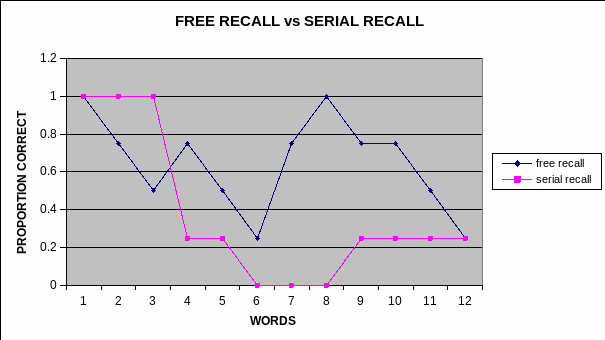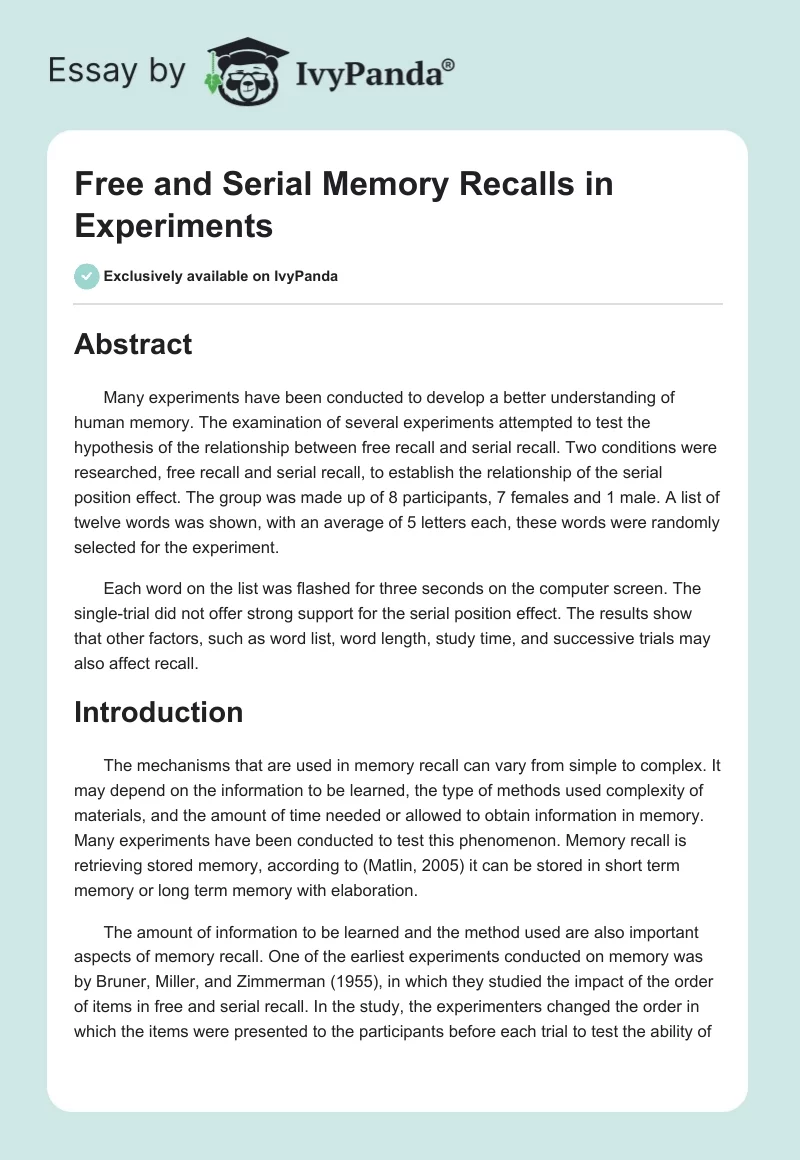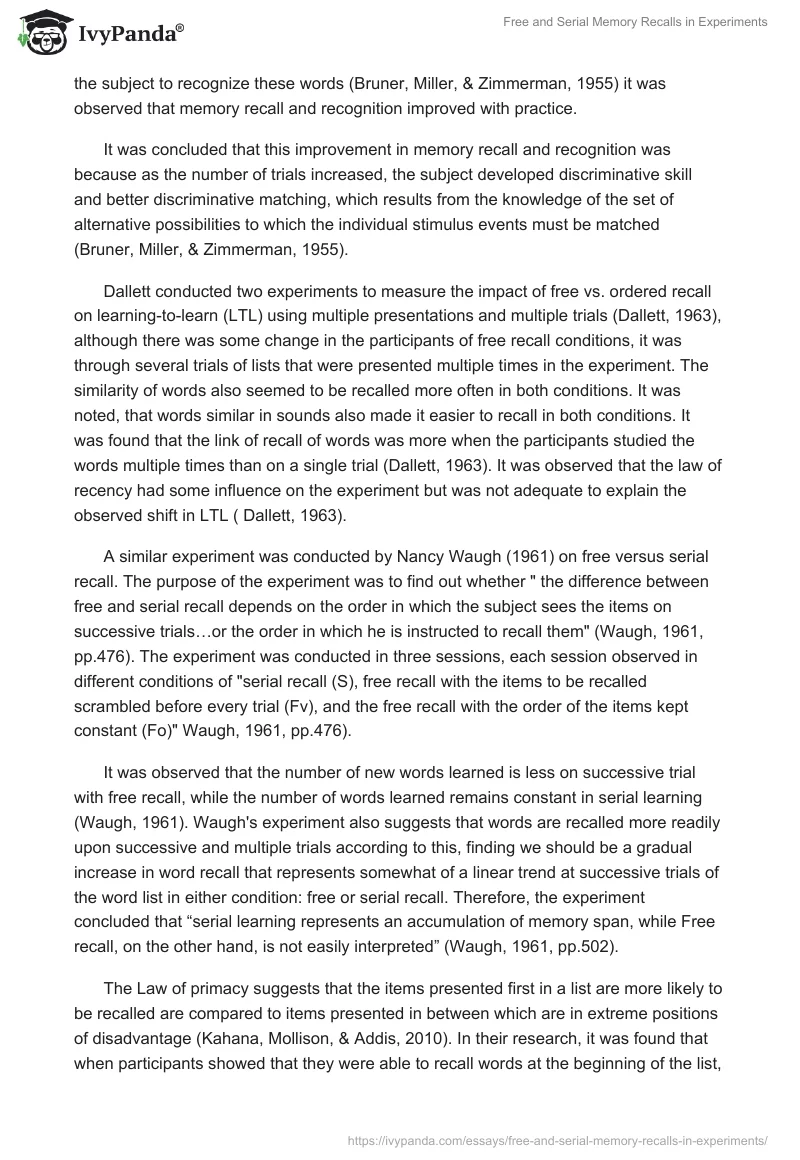Abstract
Many experiments have been conducted to develop a better understanding of human memory. The examination of several experiments attempted to test the hypothesis of the relationship between free recall and serial recall. Two conditions were researched, free recall and serial recall, to establish the relationship of the serial position effect. The group was made up of 8 participants, 7 females and 1 male. A list of twelve words was shown, with an average of 5 letters each, these words were randomly selected for the experiment.
Each word on the list was flashed for three seconds on the computer screen. The single-trial did not offer strong support for the serial position effect. The results show that other factors, such as word list, word length, study time, and successive trials may also affect recall.
Introduction
The mechanisms that are used in memory recall can vary from simple to complex. It may depend on the information to be learned, the type of methods used complexity of materials, and the amount of time needed or allowed to obtain information in memory. Many experiments have been conducted to test this phenomenon. Memory recall is retrieving stored memory, according to (Matlin, 2005) it can be stored in short term memory or long term memory with elaboration.
The amount of information to be learned and the method used are also important aspects of memory recall. One of the earliest experiments conducted on memory was by Bruner, Miller, and Zimmerman (1955), in which they studied the impact of the order of items in free and serial recall. In the study, the experimenters changed the order in which the items were presented to the participants before each trial to test the ability of the subject to recognize these words (Bruner, Miller, & Zimmerman, 1955) it was observed that memory recall and recognition improved with practice.
It was concluded that this improvement in memory recall and recognition was because as the number of trials increased, the subject developed discriminative skill and better discriminative matching, which results from the knowledge of the set of alternative possibilities to which the individual stimulus events must be matched (Bruner, Miller, & Zimmerman, 1955).
Dallett conducted two experiments to measure the impact of free vs. ordered recall on learning-to-learn (LTL) using multiple presentations and multiple trials (Dallett, 1963), although there was some change in the participants of free recall conditions, it was through several trials of lists that were presented multiple times in the experiment. The similarity of words also seemed to be recalled more often in both conditions. It was noted, that words similar in sounds also made it easier to recall in both conditions. It was found that the link of recall of words was more when the participants studied the words multiple times than on a single trial (Dallett, 1963). It was observed that the law of recency had some influence on the experiment but was not adequate to explain the observed shift in LTL ( Dallett, 1963).
A similar experiment was conducted by Nancy Waugh (1961) on free versus serial recall. The purpose of the experiment was to find out whether ” the difference between free and serial recall depends on the order in which the subject sees the items on successive trials…or the order in which he is instructed to recall them” (Waugh, 1961, pp.476). The experiment was conducted in three sessions, each session observed in different conditions of “serial recall (S), free recall with the items to be recalled scrambled before every trial (Fv), and the free recall with the order of the items kept constant (Fo)” Waugh, 1961, pp.476).
It was observed that the number of new words learned is less on successive trial with free recall, while the number of words learned remains constant in serial learning (Waugh, 1961). Waugh’s experiment also suggests that words are recalled more readily upon successive and multiple trials according to this, finding we should be a gradual increase in word recall that represents somewhat of a linear trend at successive trials of the word list in either condition: free or serial recall. Therefore, the experiment concluded that “serial learning represents an accumulation of memory span, while Free recall, on the other hand, is not easily interpreted” (Waugh, 1961, pp.502).
The Law of primacy suggests that the items presented first in a list are more likely to be recalled are compared to items presented in between which are in extreme positions of disadvantage (Kahana, Mollison, & Addis, 2010). In their research, it was found that when participants showed that they were able to recall words at the beginning of the list, their recall was correct for the following two words as well but recall for words in the middle of the list remained low. It shows that words placed in the middle of the list have a lower chance of being recalled(see fig.1), which means that they are at a disadvantage (Kahana, Mollison, & Addis, 2010).
Previous research with similar results of this memory phenomenon was conducted in 1973 (Hasher, 1973).comparison of free recall and serial recall however did not support the recency strategy as a way to better recall word list, there still seems to be other components necessary to support the serial position that may include repetition and length of word list on each trial. Hasher’s experiment found that neither condition found recall in the middle of the word list to indicate that a serial position was in effect; ironically, it showed that recall improved and continued to the end of the list for both conditions.
Depending on the individual, different memory strategies may be a factor to improve recall, which may or may not be in support of the serial position. The common factor in these experiments still seems to show that more rehearsal leads to correct recall (Matlin,2005). The experiment suggests that the subjects who were able to recall words more accurately in the serial recall trials mentally prepared themselves for associations of words than the free recall groups. This research also demonstrates that a reason why learning is positively affected in serial recall and not in the free recall is that participants tend to ignore any cues that were present in positions.
Method
Participants
Participants for this study consisted of 8 students selected from a population of undergraduate psychology majors at Brooklyn College. There were seven female and one male student that participated in this study as part of the class requirement. The participants received no monetary compensation for experiments. The ages of the participants were not reported.
Materials
Each participant used a pen, a notecard, and an XP Desktop computer equipped with Microsoft PowerPoint Presentation 2003 Program.
Procedure
At the beginning of the lab, participants were notified that they would participate in an experiment to test memory. They were a total of 8 participants who were randomly selected to be in a free recall group or a serial recall group. Each group was made of 4 participants. Each participant was sent to individual lab rooms to conduct experiments. The participants were supplied with a notecard to record the words that would be presented on the computer screen. On top of each notecard, they were instructed by the experimenter to record their id# and gender.
The participants in the free recall group were instructed to write down the words as the recalled on the notepad, while the participants in the serial recall group were supplied with note pad itemized 1 -12, with a horizontal line next to each number, for the participants to write the words exactly in the order it appeared on the computer screen. The sequence of the list of words was: Window, Soft, Music, Fruit, Chair, Sweet, Mountain, Cold, House, Sleep, Foot, and Dark: words were presented on the computer screen, one at a time in three-second intervals. At the end of the experiment, which lasted about 2 minutes, the experimenter collected notepads and completely debriefed the participants.
Results
From the data analysis that was done, we found no significant difference in the proportion of recall for words that were presented at the beginning and also at the end of the list.
However we did find a significant difference on proportion recalled for free recall conditions, (M=.75, SD = 50) and serial recall condition (M = 00, SD = 00), t (6) = 3.00, p <.024. We also found a significant difference at the 7th and 8th-word t(6) = 3.00, p <.024. All others did not produce significant differences, p>.05. One common factored noticed for both trials was that the subjects always got the first word correct.
Discussion
This experiment contributed to the serial position by the results yielded. In both the serial and free recall groups, participants were able to recall the first few words but, the following words were not easily recalled until the latter part of the series, where the free recalled were more on a positive incline than the serial recall words. One pattern was noticed for both free and serial recall for the first words. ( see fig 1) Results show that no matter what the nature of memory recall was, the mean average of the first three words recalled remained the highest for both free and serial memory recall. It may be due to the effect of primacy.
The law of primacy suggests that the items presented first in a list are more likely to be recalled because early items are rehearsed more frequently (Matlin, 2005). The results confirm the primacy effect in the experiment for both free and serial recall. It can bee is seen that all of the participants were able to recall the first word accurately for both free and serial recall ( see fig.1).
Another phenomenon noticed in the results is that of the serial position effect. It was more common for serial recall than free recall. All the participants showed similar results for a free recall since they were able to recall the words presented at the beginning of the table better than the words showed towards the end of the table. For serial recall, when the participants were able to recall one word right, the recall was correct for the following two words as well but when the participant got one word incorrect, the next two words recalled were also incorrect. It shows that the words placed in the middle of the list have a lower chance of being recalled.
One explanation might be because an association is created between words that follow each other the list is stored in memory like a chain with one part linking to the next (Matlin, 2005). When the participant got one word correct, they were more likely to get the following word correct also. The serial position also indicates that when one word was recalled out of order, it disrupted the memory, so the link was not recovered, i.e., one wrong word led to the wrong association, therefore, the next word recalled was also incorrect (Matlin, 2005).
This pattern is seen in Table 1, as one correct word is followed by another correct word and one incorrect recall leads to another. This pattern, however, is not seen in free memory recall since the subjects are not required to make any sort of association and are allowed to recall words in the order that they remember. It can be inferred that the effect of free and serial memory recall is quite different.
There were some limitations to this experiment. The sample size of 8 was perhaps too low a bigger sample size might have yielded different results that demonstrate the free vs. serial more effectively. There should have been more trials in this experiment, which may have had more impact on the experiment. There were also no calculations made of the associations the participants made in recalling the words in the serial recall session. The participants may have developed their method of associating the words to better recall them. It could be an explanation of the higher overall mean average of free recall.
References
Bruner, J. S., Miller, G. A., & Zimmerman, C. (1955). Discriminative skill and discriminative matching in perceptual recognition. Journal of Experimental Psychology, 49, 187-192.
Dallett, K. M. (1963). Practice effects in free and serial recall. Journal of Experimental Psychology, 66, 65-71.
Hasher, L. (1973). Position effects in free recall. The American Journal of Psychology,86, 389-397.
Kahana,M. J., Mollison, M. V., & Addis, K. M. (2010). Positional cues in serial learning: The spin-list technique. Memory & Cognition, 38, 92-101.
Matlin, M. W. (2005). Cognition (6th ed.)Hoboken, NJ: John Wiley & Sons.
Waugh, N. C. (1961). Free versus serial recall. Journal of Experimental Psychology, 62,496-502.



